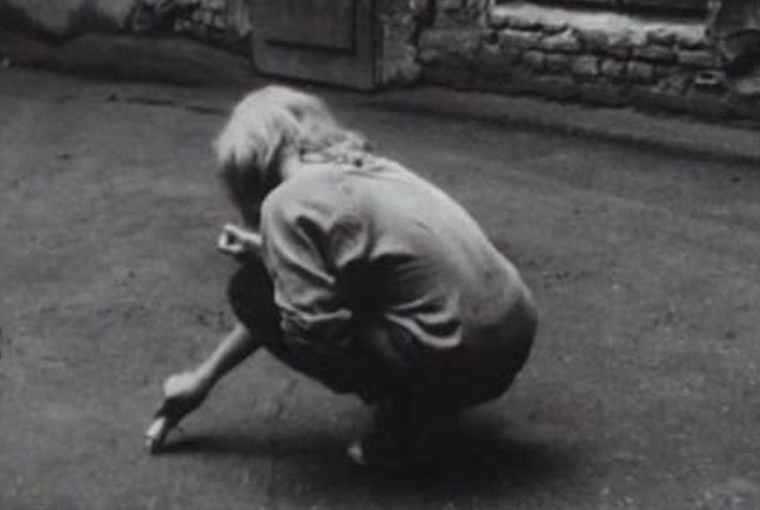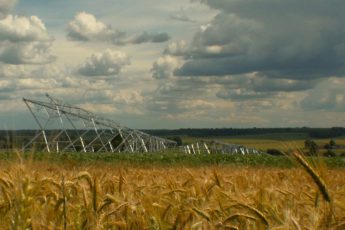Historical Contingencies in Šarūnas Bartas’ Early Films
Šarūnas Bartas’ The Corridor (1994), In Memory of a Day Gone By (1990), Three Days (1991)
Vol. 70 (December 2016) by Lukas Brašiškis
A long take of floes of ice drifting along a river is followed by a long take of two abstract figures unhurriedly walking away on a snowy flatland until they become an integral part of the landscape. These two shots open In Memory of a Day Gone By (Praėjusios dienos atminimui, 1990), Šarūnas Bartas’ second nonfiction film.1 With their contemplative nature and slow pace, the shots perfectly exemplify the distinct style of the Lithuanian director’s early films. It is not surprising that Bartas’ cinema is pretty often associated with the tradition of the Lithuanian poetic documentary. The films of Robertas Verba and Henrikas Šablevičius, in particular, are in turn characterized by “close-ups and a long and careful observation of immediate reality” 2. In this essay, however, I do not aim to retrace the history of the Lithuanian poetic documentary Bartas might have been influenced by. Since Bartas began his filmmaking career a few years before the collapse of the Soviet Union, producing his first feature length films in the aftermath of paradigmatic socio-political and cultural shifts, I rather want to analyze the image of the transition from the Soviet to the post-Soviet as it appears in his In Memory of a Day Gone By, Three Days (Trys Dienos, 1991) and, partly, The Corridor (Koridorius, 1994). It is noteworthy that Bartas himself pointed out that in the beginning of his career he had no intention of creating a historical film in the traditional sense.3 Nevertheless, his early films are acutely attentive to the material decay and the temporal halt characteristic of the early post-Soviet years.
In Memory of a Day Gone By features bits of the daily life of various residents of Vilnius’s old town in the early 1990s. There are a few recurring characters portrayed in the film: a puppeteer, an organist, and a disabled man. Words these characters utter reveal near to nothing about them, nor does their body language. The spectator sees them wandering the same streets and sometimes hears them mumbling a few words as the day goes by, a cycle that creates an audiovisual memory of the non-spectacular quotidian. Like the puppet wielded by the lonely puppeteer, all city inhabitants portrayed in this film look as if they’re being ‘held hostage’ by a plodding routine and bleak surroundings. The people are rarely centered within the frame in this film; most often they share the frame with other human and non-human subjects/objects. Moreover, a semi-diegetic pipe organ music as well as sounds of church bells ringing, in addition to an aural ambience heard from off-screen, structure the pace of the film, creating the impression that there could be something that administers disorderly movements on this plane of immanence. With no illumination, the cyclical story of one day ends with another version of the film’s opening scene: the long shot of large floes of ice slowly floating down the river follows the shot of the disabled man walking through an empty yard.
Ambience, slowness, a-centricity and scarcity of action—qualities so characteristic of In Memory of a Day Gone By are also fundamental to Three Days, the first feature film of Bartas. Like In Memory of a Day Gone By, which consists of 84 shots with an average shot length of 27 seconds, Three Days is slowly paced: the film has 213 shots with an average shot length of 21 seconds.4 Three Days tells the story of two young men who suddenly decide to leave their native village house and arrive at an unnamed town.5 Thereafter, they meander aimlessly in remote post-industrial places of the town. They establish some contact with a group of homeless people, meet two women, apparently local prostitutes, and, in what follows, spend a night in a third-rate dormitory crowded with Russian speaking people. Eventually, one of the two main protagonists (played by Audrius Stonys, the noted Lithuanian documentary director) gets drunk and is beaten by locals. After this accident, he completely disappears, while the other character continues having the seemingly complicated affair with one of the two women they met before.
According to Russian film philosopher Mikhail Iampolski, an archetypical plot of Soviet films features an ordinary person who lives outside of Grand History, but, in the course of the film, is pulled into a historical timeline and given an identity.6 A world of diegesis in Soviet films, therefore, is a world in which characters connect seamlessly with the places and events that surround them. In consequence, the story of Soviet films is usually attributed to a character and received by the spectator as if he or she were in his or her position. In early Bartas films, however, we witness a very opposite strategy of storytelling at work. As the disappearance of one of the two main characters in Three Days illustrates —a fact which is neither followed by a series of counter-actions leading to the resolution of the situation, nor is it reflected in any other way within the diegesis of the film—, early Bartas films do not seek to establish the spectator’s identification with characters’ actions. They rather aim at distancing the spectator from characters through the exposition of what Martin Lefebvre calls “landscapes” or “non-narrative spaces”—images of places that do not serve a preconceived narrative function: they are neither determined by a story of characters, nor do they express characters’ psychological states. The depiction of space in these Bartas films often does not conform to the function of point-of-view: when facial close-ups of the characters are shown, the usual reverse shot is either not given, or it does not employ eye-line matching (see image below).

Three Days (Trys Dienos, 1991)
In spite of the large number of facial close-ups presented in long shots, faces in Bartas’ films rarely evince something unequivocal about human subjectivity; they are rather visually equated with elemental landscapes. As Laura Sinagra points out in a somewhat Balázsian manner, in early films by Bartas “countenances are landscapes, and human actions are only as knowable—placidly predictable or violently mutable—as observed natural phenomena” 7. In early Bartas films, therefore, human subjects are bereft of a proactive agency and, like all the other objects featured, they are exposed to the flow of time that is slowly shaping their lives. Thus, instead of pulling his characters into the center of progressive history, Bartas portrays them as an integral part of contingent spaces. His films resist representing macro events and, at once, portray micro transformations that (re)establish the spectator’s experience of a distressing singular dimension of the past, not a soothing totality of it.
Notably, Three Days closes with a two minute-forty second time-lapse shot of the village house. This static scene, which does not feature the main characters, illustrates the narrative autonomy that spaces acquire in Bartas’ films: snow, rain and fog appear within the same shot, not the characters. Of course, it is by no means just the opening and closing scenes of Bartas’ early films that present spatial images of elemental materiality which would be considered unnecessary or bewildering from the perspective of conventional narrative cinema. There is the slow movement of leaves rustling in the wind, the seagulls gliding over the sea, the smoke rising above the factory, the pigeons inhabiting the landfill, or the ripples of water slowly ruffling—and the list of incidental images existing outside the primary diegesis could easily be continued. All these images, shot in relatively long takes, explicate a cinematic operation of contingency. It is this operation that has been extensively discussed by early film theorists, who agreed more or less about cinema’s exceptional sensitivity as a recording medium which can capture and reproduce unintended, unconscious and otherwise unnoticeable characteristics of the physical world. Dziga Vertov with his ideas on mechanical “kino-eye” that, through overcoming limitations of human vision, can enable a fresh image of the material world,8 Maya Deren with her thoughts on cinema as “the art of controlled accident”,9 André Bazin with his writings on cinema’s openness to the ambiguity of the real,10 Walter Benjamin with his concept of “optical unconscious”,11 and Siegfried Kracauer, who was generally interested in a “redemption of physical reality”,12 all believed in cinema’s exceptional ability to record aleatoric events and to expose the spectator to the unpredictability of the world. What one witnesses in Bartas’ early films, is thus an unorthodox look at the world, celebrated by pre-academic film theorists, that, in Siegfried Kracauer’s words, exposes “a flow of chance events, scattered objects, and nameless shapes”, thus producing “a fringe of indeterminate visible meanings”.13 And yet, despite the lack of character-centered teleological storytelling and narrative determinacy, it would be an oversight to equate first Bartas’ films with non-historical cinema. Instead, the uncertainty and openness of narrative meanings in Bartas’ early films is a result of, as well as a reflection upon, a particular historical situation.
As many state, the Socialist collectivist time in the Soviet Union was characteristically future-oriented. According to Dobrenko, in the Stalinist Soviet Union “in order to free the ground for the new future, the present was shifted into the past, and the future-directed future was transformed into the present, as a result of which the real present itself underwent complete de-realization“14. However, in the late 1980s the past was reconsidered and a future-oriented collective temporality came to a halt. The idea of linear time started to play only a cursory role in the period of the Soviet-to-post-Soviet transition: having lost the element of progression, time acquired a durational nature that allowed spatial images to take over in an articulation of historical experience. Bartas’ early films are apt examples of this kind of articulation. Instead of telling progressive (his)stories of the end of the Soviet times and the beginning of the new post-Soviet era, these films highlight the subservience of human teleology to the elemental. By doing so they mark a time in which any-events-whatsoever were regarded as historical events, whereas the dominant historical events were reinterpreted as purely aleatoric events. “What we make history with is the matter of a becoming, not the subject matter of a story”, Deleuze and Guattari once claimed.15 In Bartas’ films, vitalist undertones of this unorthodox philosophical conception of history acquire a form and a sense of realist images. The way the Lithuanian director’s second fiction film The Corridor (1994) features documentary footage of the Lithuanian uprising illustrates that perfectly. Neither explained, nor interiorized into the characters’ actions or thoughts, the archival images of the dominant historical event—a preparation for the defense of the Lithuanian parliament from the potential Soviet army attack in the 1991—are presented in the film without a narrative motivation, as if they would not have any particular importance in the lives of the characters who are shown ‘being trapped’ in their claustrophobic wooden house. Occasionally, the main character (played by Bartas himself) passively observes the demonstrations through the window of his house, not being able to establish any meaningful relationship with the ongoing situation outside.
Thus, as the usage of the historical footage in The Corridor illustrates, even if objects and places in Bartas’ films emancipate themselves, that is not because they would do so always and in all of his films. In other words, despite the fact that the first three films by Bartas are not predicated on diegetic spaces that pre-exist their own filmic representations, I still argue that the temporal indeterminacy and spatial contingency of In Memory of a Day Gone By, Three Days and The Corridor can be associated with a particular regime of historicity of the late 1980s and early 1990s. I admit that such a hermeneutical exploration of Bartas’ films by no means stands for a complete study of early works by the Lithuanian director. However, I believe that even if this kind of analysis reduces meanings of his films and overlooks other possible interpretations of their aesthetic and philosophical subtexts, it provides the possibility of understanding the aesthetics of these films in the context of their production time. In “Toward a Radical Historicity”, a chapter from Change Mummified: Cinema, Historicity, Theory, Philip Rosen highlights the importance of a socio-cultural and temporal positionality that allows filmmakers to creatively oppose the prevailing modes of storytelling.16 Along the same line, I suggest that manifestations of spatial contingency and temporal indeterminacy in Bartas’ early films should be understood as rooted in and inseparable from the commitment to create a cinema that arises from the specifics of a particular situation and a particular regime of historicity.




Leave a Comment